Schillinger, Josef born, 21-01-1908, in Oberrimsingen,  Breisgau-Hochschwarzwald, Baden-Württemberg, Germany. Josef a cooper by trade, had been a member of the SS (SS No. 47468) since the beginning of September 1939. His highest rank was SS-Oberscharführer
Breisgau-Hochschwarzwald, Baden-Württemberg, Germany. Josef a cooper by trade, had been a member of the SS (SS No. 47468) since the beginning of September 1939. His highest rank was SS-Oberscharführer ![]() (Senior Squad Leader). After the establishment of the Auschwitz-Birkenau concentration camp,
(Senior Squad Leader). After the establishment of the Auschwitz-Birkenau concentration camp,  Schillinger was assigned there as a roll call leader in the men’s camp. From the end of October 1942, Schillinger served for several weeks as commander of the Chełmek subcamp of Auschwitz. There, concentration camp prisoners were forced to dig a pond under inhumane working conditions, which was intended to serve as a water reservoir. Schillinger’s last duties included serving as head cook and roll call leader in the men’s camp of Auschwitz-Birkenau.
Schillinger was assigned there as a roll call leader in the men’s camp. From the end of October 1942, Schillinger served for several weeks as commander of the Chełmek subcamp of Auschwitz. There, concentration camp prisoners were forced to dig a pond under inhumane working conditions, which was intended to serve as a water reservoir. Schillinger’s last duties included serving as head cook and roll call leader in the men’s camp of Auschwitz-Birkenau.
Death and burial ground of Schillinger Josef.

On 23-10-1943, a transport of 1,800 Jewish prisoners, so-called exchange Jews, arrived at Auschwitz-Birkenau from the Bergen-Belsen concentration camp;  they had been assured of emigration to Switzerland. Under the supervision of Rapportführer Schillinger, SS men escorted the arriving prisoners from the ramp to Crematorium II.
they had been assured of emigration to Switzerland. Under the supervision of Rapportführer Schillinger, SS men escorted the arriving prisoners from the ramp to Crematorium II. 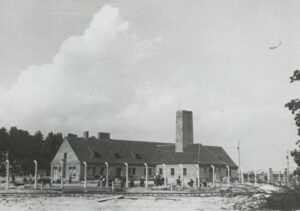 There, the unsuspecting inmates were ordered to undress in the undressing room for a subsequent “disinfection.” A young Jewish woman—a Polish Jewish ballerina named Franciszka Mann
There, the unsuspecting inmates were ordered to undress in the undressing room for a subsequent “disinfection.” A young Jewish woman—a Polish Jewish ballerina named Franciszka Mann  —saw through the deception and refused to remove her clothing.
—saw through the deception and refused to remove her clothing.
Franceska Mann was a young dancer residing in Warsaw before World War II. Franceska studied dance in the dance school of Irena Prusicka.  Her friends at that time included Wiera Gran
Her friends at that time included Wiera Gran 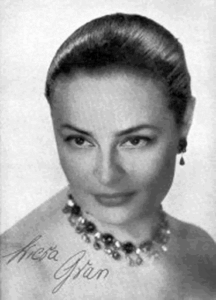 and Stefania Grodzieńska.
and Stefania Grodzieńska. 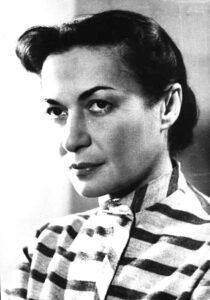 In 1939 Franseka was placed 4th during the international dance competition in Brussels among 125 other young ballet dancers. She was considered one of the most beautiful and promising dancers of her generation in Poland, both in the classical and modern repertoire.
In 1939 Franseka was placed 4th during the international dance competition in Brussels among 125 other young ballet dancers. She was considered one of the most beautiful and promising dancers of her generation in Poland, both in the classical and modern repertoire.
At the beginning of World War II she was a performer at the Melody Palace nightclub in Warsaw.  She was a prisoner in the Warsaw Ghetto. In several publications she is mentioned as a German collaborator. Her name is associated with the “Hotel Polski affair”.
She was a prisoner in the Warsaw Ghetto. In several publications she is mentioned as a German collaborator. Her name is associated with the “Hotel Polski affair”.

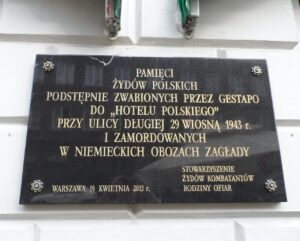
According to the detailed account of Filip Müller,  a Jewish Slovak Holocaust survivor and a member of the Sonderkommando at Auschwitz, the largest Nazi German concentration camp during World War II, where he witnessed the murders of tens of thousands of people, she wrested a pistol from SS-Oberscharführer Walter Konrad Quakernack
a Jewish Slovak Holocaust survivor and a member of the Sonderkommando at Auschwitz, the largest Nazi German concentration camp during World War II, where he witnessed the murders of tens of thousands of people, she wrested a pistol from SS-Oberscharführer Walter Konrad Quakernack 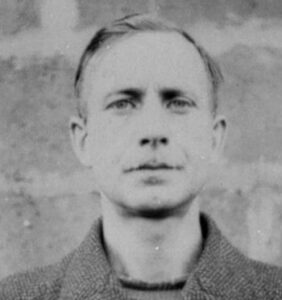
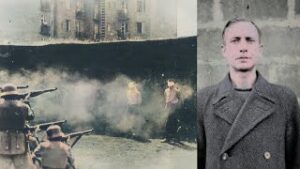 and fired three shots; the first hit Schillinger, a second missed Quakernack, and the third wounded SS-Oberscharführer Wilhelm Emmerich.
and fired three shots; the first hit Schillinger, a second missed Quakernack, and the third wounded SS-Oberscharführer Wilhelm Emmerich.  The other women in the undressing room also resisted their impending murder. The uprising was crushed by machine gun fire, and the surviving women were subsequently gassed. Differing accounts of this event exist. Walter Konrad was arrested by Allied forces and held at Celle and Lüneburg. He was sentenced to death at the second Belsen Trial in June 1946. He was hanged on 11-10-1946, age 39.
The other women in the undressing room also resisted their impending murder. The uprising was crushed by machine gun fire, and the surviving women were subsequently gassed. Differing accounts of this event exist. Walter Konrad was arrested by Allied forces and held at Celle and Lüneburg. He was sentenced to death at the second Belsen Trial in June 1946. He was hanged on 11-10-1946, age 39.
During the Holocaust, Sonderkommandos  were randomly assigned, strong-looking male prisoners who, under pressure from the SS,
were randomly assigned, strong-looking male prisoners who, under pressure from the SS,  helped deceive victims in extermination camps (pretending the gas chamber was a shower room), herding them into the gas chamber to be murdered, and dragging the corpses out. They then had to separate the “usable parts” of the corpses: they broke gold teeth from the mouths of the dead and cut off the long hair of women.
helped deceive victims in extermination camps (pretending the gas chamber was a shower room), herding them into the gas chamber to be murdered, and dragging the corpses out. They then had to separate the “usable parts” of the corpses: they broke gold teeth from the mouths of the dead and cut off the long hair of women.
Josef Schillinger, age 35, died on the way to the hospital from his severe gunshot wounds. His body was transported to Oberrimsingen and buried with full military honors on the Oberrimsinger Friedhof, Breisach am Rhein, Landkreis Breisgau-Hochschwarzwald, Baden-Württemberg, Germany. L134, 79206 Breisach am Rhein, Germany..
In the 1961 trial against Adolf Otto “Siggi-Eichmann” Eichmann,  witness Aharob Beilin
witness Aharob Beilin  testified that Schillinger had committed the most heinous atrocities in Birkenau. The testimony did not go into detail, but only briefly described the uprising at Crematorium 4 that led to Schillinger’s death.
testified that Schillinger had committed the most heinous atrocities in Birkenau. The testimony did not go into detail, but only briefly described the uprising at Crematorium 4 that led to Schillinger’s death.
In an interview recorded around 2016, Auschwitz survivor Leon Henry Schwarzbaum

 describes Schillinger’s character and the circumstances of his death. According to Schwarzbaum, Schillinger was shot by a young female inmate with his own revolver, an act that even his SS comrades found “joyful” “because he was a brutal man.”
describes Schillinger’s character and the circumstances of his death. According to Schwarzbaum, Schillinger was shot by a young female inmate with his own revolver, an act that even his SS comrades found “joyful” “because he was a brutal man.”
In 2003, amateur historian Andreas Meckel successfully petitioned the mayor of Breisach to have Schillinger’s gravestone removed from the war memorial in Oberrimsingen. Meckel had learned of Schillinger’s burial site and refused to accept that a perpetrator of the Holocaust was commemorated with a gravestone while millions of Holocaust victims were denied this personal remembrance. Furthermore, Schillinger’s name was also removed from the local war memorial. The circumstances of Schillinger’s death are documented and represent the resistance of the victims against their impending murder.

















Leave a Reply